-
mswisher

- Posts: 4
- Joined: Mon May 23, 2022 5:01 pm
Re: Collecting moths in places not near home - how to bring equipment?
by mswisher » Fri Nov 08, 2024 10:31 pm
-
58chevy
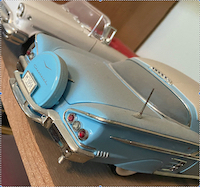
- Posts: 461
- Joined: Mon May 23, 2022 5:58 pm
Re: some assembly required
by 58chevy » Fri Nov 08, 2024 5:03 pm
-
58chevy

- Posts: 461
- Joined: Mon May 23, 2022 5:58 pm
Re: Does Papilio rutulus have a spring form? And more...
by 58chevy » Fri Nov 08, 2024 4:46 pm
-
Chuck

- Premium Member - 2024

- Posts: 1156
- Joined: Mon May 23, 2022 2:30 pm
Re: Tiger Swallowtails of NY: Finger Lakes, Part II
by Chuck » Fri Nov 08, 2024 2:18 pm
I make no inference that any of these hold taxonomic status, or are forms, or whatever. I refer to each as a "morph" for lack of better standing.
What I don't depict, but may add later, is the June morph/ flight that used to be common in the 1970s and 1980s.
THIS IS WORK IN PROGRESS. Saved so if there's a hiccup I don't lose everything.
#1. I thought this was canadensis until Eurytides said "no it's not" and I took a closer look. Previous images of this specimen used in the seasonal reports for NYS reference this specimen as canadensis, which I now know is wrong.
DESCRIPTION: Very small, very hairy. Has the big "mohawk" like canadensis. Longer tails than canadensis. HW lunules more like glaucus. Claspers are yellow-brown, not mottled like canadensis.
OCCURANCE: Mid-may, first flying morph. This morph occurs along the SE shore of Lake Ontario, which is very cold in Spring. Somewhere as one wraps east then north around Lake Ontario this morph it runs into, and then is replaced by, canadensis. Not common, very difficult to capture; never observed nectaring but rather a ground-feeder.
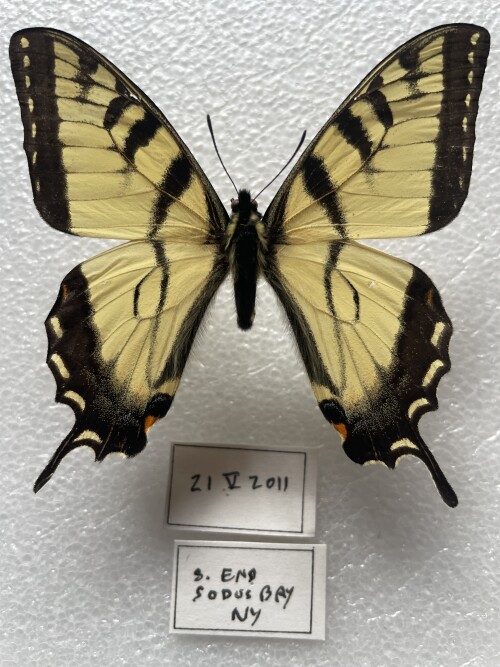
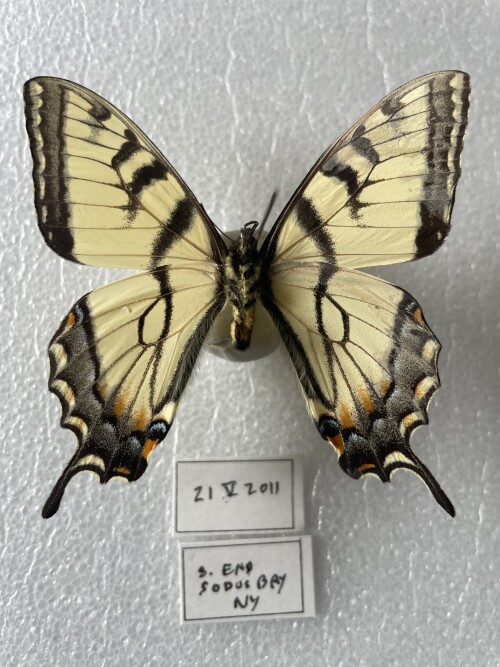
#2. Rather common in late May in the hilly regions of Finger Lakes. Still a bugger to catch.
DESCRIPTION: Mid-sized between canadensis and MST. Universally pale yellow upper side; little variation in individuals.
OCCURANCE: Mid- to late-May. If timing is right, it can be found nectaring on Lilac. Hilly regions, including towns, below US Routes 5 & 20, particularly along the shorelines of the Finger Lakes themselves. A forest flyer, often seen battling near forest edge. Comes low only to nectar or ground feed.
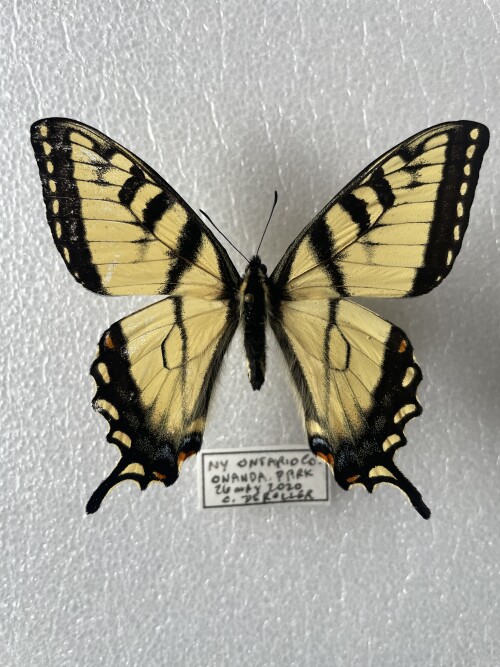
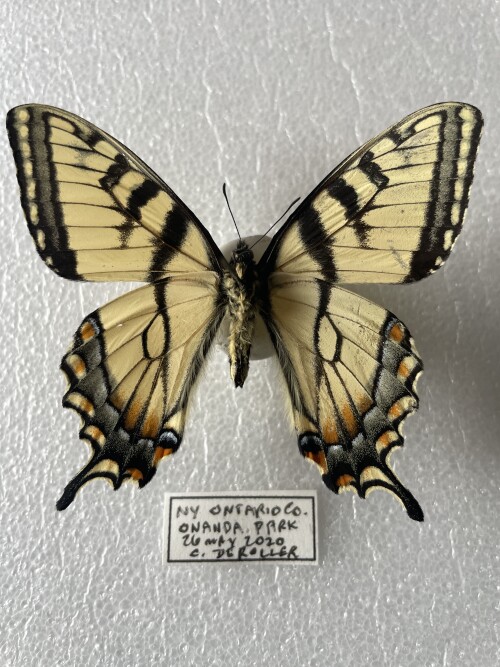
#3. Same size as MST, larger than #2 above. It's hard from photos, but in real life they appear different and act differently than #2. Discernability from MST is questionable.
DESCRIPTION: Like #2 above, but yellow upper side is more orangish. Larger than #2, about the same size as MST.
OCCURANCE: Late May- ??. Likes to hilltop. Flies on forest canopy whether that's 80' oaks or short scrub. Quite commonly seen when temperature above 65F and sunny, likes to fight. Will alight on sun-drenched trees that are not the foodplant, with multiple individuals on one tree; when frightened will return. Still a bugger to catch.

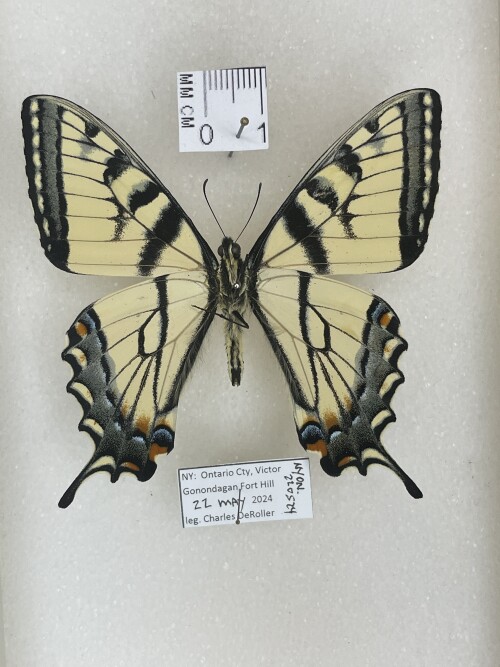
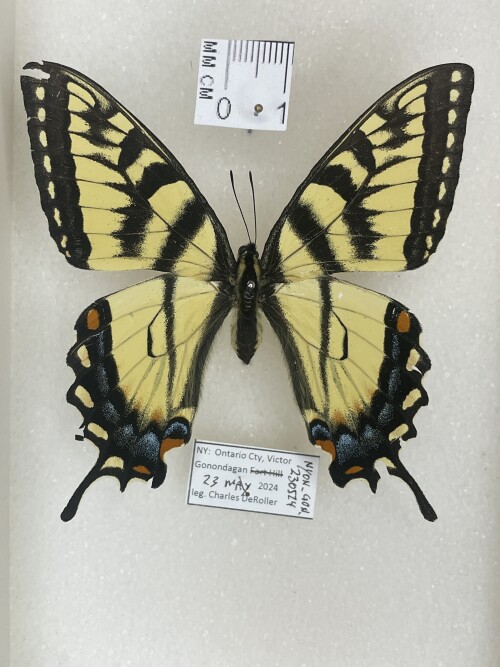
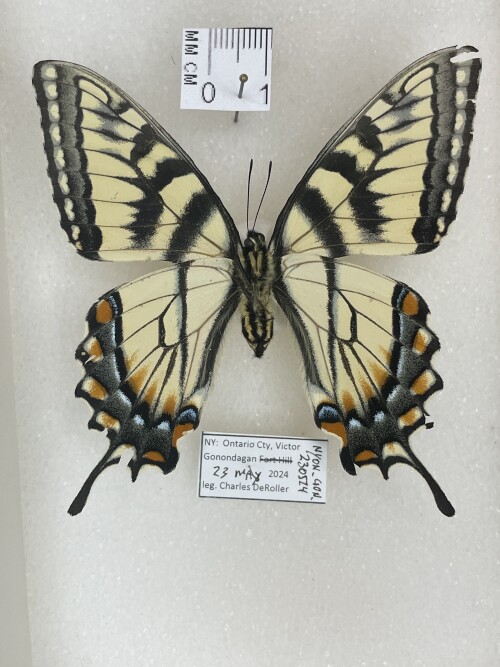
#4. Now, this is where things get dicey. Up in eastern Ontario Canada, where Eurytides studies, an area where Tigers including MST have been very well documented, it's easy- a flight of canadensis, then a flight of MST with virtually no overlap. As one can see so far, from mid-May (14 May to be exact, never earlier, but maybe a few days later if 14 May is rainy) through (below) June there are Tigers...which rolls straight into the ~01 July MST emergence. And, as you will note in specimen #4 below, it becomes very difficult to discriminate between these June Tigers and MST based on morphology alone. This specimen was ovipositing on apple, not a recognized larval food plant.
DESCRIPTION: I can't tell from MST; within morphology of MST. Same size as MST.
OCCURRANCE: Not common; far less frequent than #2 / #3 above. Some years I've seen zero in June. Explain that.
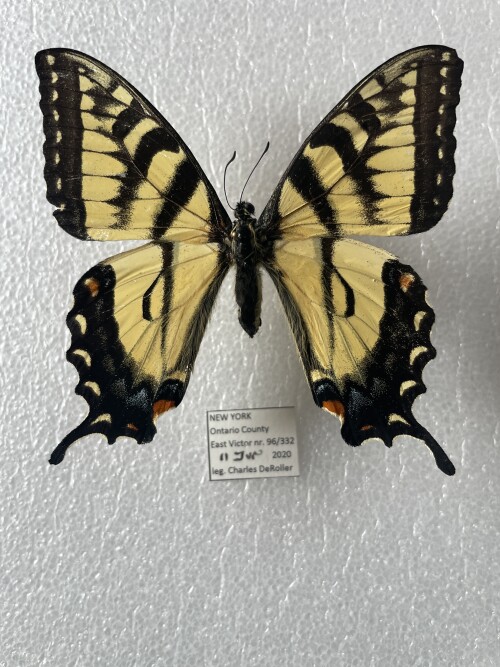

VIRGINIA
The following are Spring Form "glaucus" from the Appalachian Mountains of Virginia. Constrast these to Pavulaan's Spring Form confirmed "glaucus" Figures 12-17 from Rhode Island. These from Virginia don't look very glaucus-y or like Pavualaan's. More later.
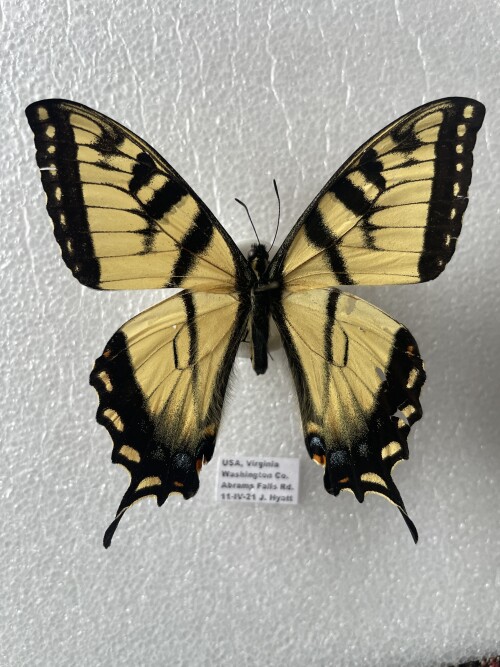
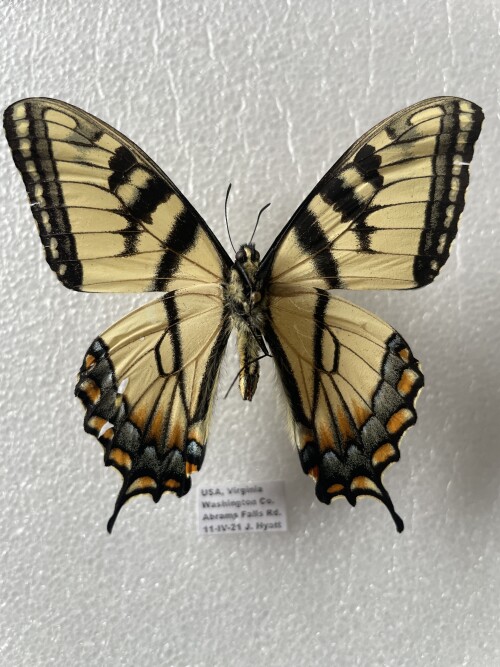
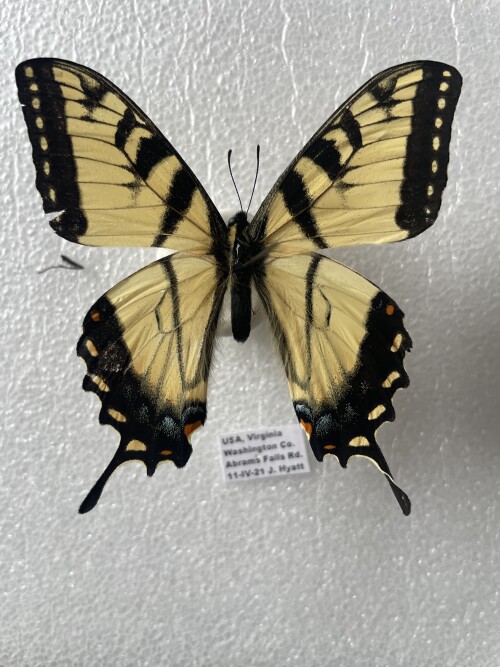

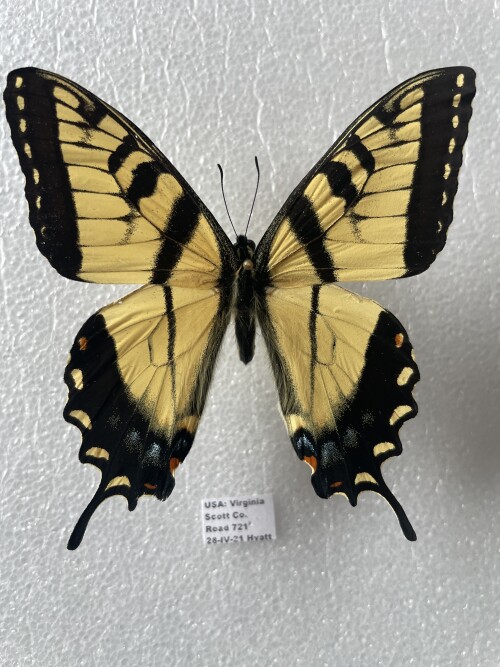

-
Chuck

- Premium Member - 2024

- Posts: 1156
- Joined: Mon May 23, 2022 2:30 pm
Re: Tiger Swallowtails of NY: Finger Lakes, Part II
by Chuck » Fri Nov 08, 2024 1:06 pm
Anyway, check this out, I call it "Lycaenid-like"; beyond the size, note the rounded wings and lack of HW scalloping.
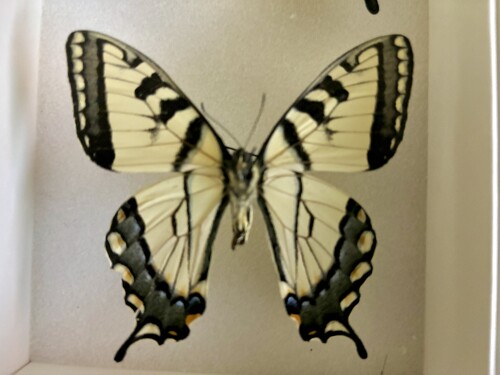
-
Jshuey
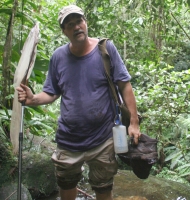
- Global Moderators

- Posts: 189
- Joined: Tue Mar 22, 2022 2:27 pm
Re: some assembly required
by Jshuey » Fri Nov 08, 2024 12:46 pm
I don't know what is in this but I do know that it is similar to model aircraft "dope" - which is a paint that has a very unique smell. If you have ever used this stuff - you know. I just Googled it and the thinner is butyrate, whatever that is. You can find it in hobby shops or on line. I tried buying clear dope once - but it did not adhere very well to insect cuticle.biscuit153 wrote: ↑Thu Nov 07, 2024 4:06 am Beautiful work.
Bioquip adhesive is great. I've worried about where I might get it in the future. Does anyone have any idea what this adhesive is or where it can be sourced?
john
-
Chuck

- Premium Member - 2024

- Posts: 1156
- Joined: Mon May 23, 2022 2:30 pm
Re: Does Papilio rutulus have a spring form? And more...
by Chuck » Fri Nov 08, 2024 12:29 pm
Last night I decided to tackle both the Drawer From Hell ("canadensis") and Spring Forms, and clean that mess.
Two specimens from May from Jefferson and Boulder counties CO were labeled "canadensis", and are quite small, but there are no canadensis reported from CO. Thus the reason for that question. These are what I'd call Spring Form, looking more-canadensis than summer rutulus, but I guess they provisionally go into the rutulus drawer. Let someone else figure it out.
And in moving some of the clearly-not-canadensis, a couple specimens went into the rutulus drawer where I re-noticed that a couple specimens from CA (not same location) have very hooked FWs.
-
adamcotton

- Global Moderators

- Posts: 908
- Joined: Tue Mar 22, 2022 12:24 pm
Re: Does Papilio rutulus have a spring form? And more...
by adamcotton » Fri Nov 08, 2024 10:21 am
Of course it is possible that there could be unrecognised taxa in what is currently treated as Papilio or Pterourus rutulus.
Adam.
-
adamcotton

- Global Moderators

- Posts: 908
- Joined: Tue Mar 22, 2022 12:24 pm
Re: Papilio bjorkae (Pavulaan, 2024) Tiger Swallowtail
by adamcotton » Fri Nov 08, 2024 9:21 am
Bear in mind also that the Code has to cover the myriad of different organisms in Zoology, some of which may for whatever reason be difficult to illustrate or photograph.
Adam.
-
eurytides

- Posts: 225
- Joined: Tue May 24, 2022 1:36 am
Re: Papilio bjorkae (Pavulaan, 2024) Tiger Swallowtail
by eurytides » Fri Nov 08, 2024 5:45 am
-
kevinkk
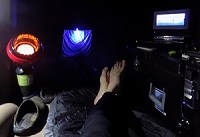
- Premium Member - 2024

- Posts: 431
- Joined: Mon May 23, 2022 5:06 pm
Re: Does Papilio rutulus have a spring form? And more...
by kevinkk » Fri Nov 08, 2024 12:07 am
there being different rutulus forms.
I wasn't aware of a possible Calif. "something". We have mountain ranges that probably deter population mixing, and the Pacific coast is long and has varied geography.
I have found Papilio zelicaon in very different sizes between coastal and inland populations, and eurymedon seems to have some size variation
as well, but that's just personal observation and without any leg work trying to track down differences.
Actually, I've expected this to come up, presumably by someone with a good answer to your question.
OK. Tyler's Swallowtails of North America 1975 mentions a possible subspecies near Reno NV called ammoni, and a subspecies arizonensis.
Pyle doesn't mention anything in his Butterflies of Cascadia.
-
Chuck

- Premium Member - 2024

- Posts: 1156
- Joined: Mon May 23, 2022 2:30 pm
Does Papilio rutulus have a spring form? And more...
by Chuck » Thu Nov 07, 2024 11:26 pm
Is there a spring form- small, canadensis-like that flies in parts of Colorado where canadensis is not reported?
What about the hooked-FW rutulus from California? Are they a separate ssp? Any insights?
Thanks!
-
Eleodes
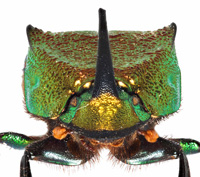
- Posts: 20
- Joined: Tue May 24, 2022 5:45 am
Re: Collecting moths in places not near home - how to bring equipment?
by Eleodes » Thu Nov 07, 2024 7:25 pm
-
Cabintom
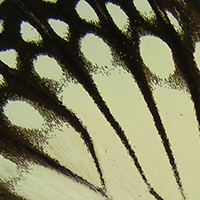
- Posts: 271
- Joined: Sat Jun 04, 2022 1:54 pm
Re: Euphaedra sp. (I.D.) requested
by Cabintom » Thu Nov 07, 2024 6:23 pm
2. Euphaedra (Medoniana) medon
3. Euphaedra (Euphaedrana) ceres
4. Euphaedra (Euphaedrana) phaethusa
-
bobw

- Global Moderators

- Posts: 232
- Joined: Tue Mar 22, 2022 2:53 pm
Re: Papilio bjorkae (Pavulaan, 2024) Tiger Swallowtail
by bobw » Thu Nov 07, 2024 5:35 pm
-
Chuck

- Premium Member - 2024

- Posts: 1156
- Joined: Mon May 23, 2022 2:30 pm
Re: Papilio bjorkae (Pavulaan, 2024) Tiger Swallowtail
by Chuck » Thu Nov 07, 2024 2:42 pm
This strikes me as odd, given the ubiquitous nature of cameras, software, and publishing software that accommodates photos. It strikes me as ironic that The Code is so picky about small details, yet doesn't demand something that's significantly useful. But it is what it is.adamcotton wrote: ↑Thu Nov 07, 2024 2:25 pm
Bear in mind that illustrations are not mandatory so there is often only a description, and subsequent researchers may want to access the holotype for study purposes.
-
Chuck

- Premium Member - 2024

- Posts: 1156
- Joined: Mon May 23, 2022 2:30 pm
Re: Papilio bjorkae (Pavulaan, 2024) Tiger Swallowtail
by Chuck » Thu Nov 07, 2024 2:38 pm
That's what I currently do. But if I'm going to swap out the yellow and red labels on "look at this one" specimens, is there any convention or preference? It's not just for my personal use, there's a number of specimens that I think should be flagged to the new owner when I surrender my collection.adamcotton wrote: ↑Thu Nov 07, 2024 2:34 pm
It would actually be better to use a white data label and add a second blank coloured label that can be discarded/reused for personal use.
Adam.
-
adamcotton

- Global Moderators

- Posts: 908
- Joined: Tue Mar 22, 2022 12:24 pm
Re: Papilio bjorkae (Pavulaan, 2024) Tiger Swallowtail
by adamcotton » Thu Nov 07, 2024 2:34 pm
This convention only applies to type specimens, particularly the label denominating the status of the specimen rather than the data label. There is no actual issue with using coloured data labels for specimens in a collection although normally data labels are on white paper or card. I would recommend that such data labels be carefully copied onto a white label for specimens that will be designated as types of new taxa.Chuck wrote: ↑Thu Nov 07, 2024 12:35 pm Whether rule of law via the Code or not, I want to follow convention. I did not know this, so may have some work to do.
So next question then- what color for the "look at this one in the future"? I have a number of specimens with yellow or red labels that, to me, mean they need further investigation.
It would actually be better to use a white data label and add a second blank coloured label that can be discarded/reused for personal use.
Adam.
-
adamcotton

- Global Moderators

- Posts: 908
- Joined: Tue Mar 22, 2022 12:24 pm
Re: Papilio bjorkae (Pavulaan, 2024) Tiger Swallowtail
by adamcotton » Thu Nov 07, 2024 2:25 pm
Chuck, that's the LOCALITY of the holotype. The LOCATION is where it is currently or will be housed. In the original description of a new species group taxon (species or subspecies) it is mandatory to state where the holotype is currently housed OR the name of an institution where it will be deposited in future*, so that researchers can access the name-bearing type specimen if necessary.
Bear in mind that illustrations are not mandatory so there is often only a description, and subsequent researchers may want to access the holotype for study purposes.
* Note that failure to deposit the holotype in the stated institution does not affect the availability of the name, unlike failure to include a statement of location in the original description. The location of the holotype can be a private collection, but it is recommended that holotypes be deposited in an institution.
Adam.
-
Chuck

- Premium Member - 2024

- Posts: 1156
- Joined: Mon May 23, 2022 2:30 pm
Re: some assembly required
by Chuck » Thu Nov 07, 2024 2:16 pm
We've discussed this before; do not use Elmer's glue, it will fall apart with moisture. I presume the BioQuip glue is fast setting- maybe a cyanocrylic super glue? I use top quality (and price) wood glue, which looks like Elmer's, but isn't hydroscopic. It takes hours to fully cure, but if I make a mistake when placing wings, etc. I'm not stuck with that forever.
Nice job, John. I hate to toss specimens because they fall apart.
